One of my greatest joys in traveling is discovering new things – history, city sights, meeting people, and – of course – food. A recent trip to France introduced me Comte cheese and it’s quickly shooting to the top of my favorite cheese list.
What’s so special about Comte cheese?
Comte is known for its history of cooperative production and is one of France’s most recognized cheeses. Let’s explore its origins, production requirements under France’s strict DOC framework, and the signature flavors that have made Comte a cheese lover’s mainstay.

Comté is an alpine-style cheese distinguished by its controlled origin, traditional production methods, and flavor complexity developed through aging. Its story is as much about the region and its community as it is about the distinctive cheese itself. It’s a notable example of French culinary heritage.
Psssst! It tastes terrific too! But let’s not get ahead of ourselves.
Origins and Historical Background of Comte Cheese
Comte comes from eastern France, specifically the Jura Massif, a mountainous region right next door to Switzerland. It is a hard cheese made from unpasteurized cow’s milk
The origins of Comté date back over a thousand years. It was traditionally produced in “fruitieres” – cooperative dairy farms where farmers pooled their milk to make larger cheeses collectively. This cooperative spirit continues today and is a fundamental part of Comte’s identity and production system, and its history is intertwined with rural life in the Franche-Comté region, reflecting centuries-old agricultural and cheesemaking traditions that have been refined and maintained through generations.
Despite its rustic roots, Comte’s reputation spread well beyond the Jura. By the Middle Ages, the cheese was found in local markets, and by the 19th century, it was regularly shipped to Paris and beyond. But it clings to its roots, with cooperative production still at its heart.
Comte holds a prestigious French designation known as Appellation d’Origine Contrôlée (AOC), which protects its traditional production methods and geographical origin. This designation has been in place since 1958, making Comte one of the first French cheeses to receive this form of recognition. It has also been granted a Protected Designation of Origin (PDO) under broader European regulations, which further confirms its important ties to the region and traditional practices.
DOC and AOC Requirements
The protection of Comte by both French and European law underscores its cultural significance and the importance placed on preserving its traditional production methods. Production is strictly controlled, right down to the breed of cows, diets, land, and the methods used throughout the cheesemaking process. These protections help safeguard the environmental balance of the Jura pastures and ensure the quality and authenticity of Comte cheese despite modern pressures.
Comte remains one of the most highly produced AOC cheeses in France, appreciated by aficionados for its rich history, regulated production, and complex, flavors.

Here is an overview of some of the requirements for the production of Comte:
- Region: Only cheese made in the departments of Jura, Doubs, and a part of Ain, at elevations between 400 and 1,200 meters, can be labeled as Comte.
- Cows: Only raw milk from Montbeliarde and French Simmental cows, grazing in natural pastures, is used.
- Feed: Pastures must be free of pesticides, and feed is strictly controlled – no silage or GMOs – preserving both quality and biodiversity. Happy cows grazing in pastures rich in wildflowers and a variety of grasses.
- Production Radius: Each fruitiere collects milk from farms within a 17-mile radius of their cheesmaking facility.
- Timeframe: Cheese production starts within 24 hours of milking.
- Milk: Unpasteurized milk is used, with only one heating allowed (up to 133 degrees Fahrenheit).
- Aging: Cheese must age for at least four months. Various aging times, from 8-36 months, give this French cheese nuance and depth in flavors. (I think my sweet spot is 9 months, but 18 months was a very close second).
- Identification: Every wheel receives a casein label with production details and must be matured on spruce boards.
Regular inspections and a grading scale from 1–20 help ensure consistent, traditional quality. Only the best cheeses – those scoring above 15 – receive the green “Comte” label on their side. (NOTE: There is also a brown label which is used when a cheese doesn’t quite measure up. It’s sold as seconds, and while still tasty, doesn’t toe the very strict mark required.)
Production Process and Community
Comte’s cooperative system is not just about efficiency. It’s a matter of heritage and pride.
Milk from local cows is delivered daily to the fruitieres, where cheesemakers continue centuries-old routines: warming milk in copper vats, curdling with natural ferments, pressing, and salting. The pressed curds form rounds that are aged and brushed regularly, developing flavor and texture over several months. Or years.




The natural diet of the cows significantly influences the character of the cheese. This means that a wheel of Comte from one location will likely be different from a wheel in another area, even if that’s just a handful of kilometers (miles) down the road. It also means that the Comte I ate in France will be different than the Comte that I purchase at home.
The cheesemaking process involves heating the milk gently, adding natural ferments, coagulating with rennet, cutting and cooking the curds, then pressing and aging the cheese, all while following traditional methods. It is then molded into large wheels (about 110 pounds), and set to age. During the aging process, a dusty-brown rind develops while the inside is a pale, creamy yellow. The texture becomes firm during the aging process, and the cheese wheels are regularly turned and washed with brine to form the rind and encourage the development of flavor.
Tasting Comte: Flavor and Texture
Comté is a semi-hard cheese, typically pale to deep yellow in color, with occasional small holes (“eyes”) and a natural, brushed rind. Texture varies from supple and open in younger wheels to firm and crystalline in older ages. The cheese’s flavor is famously complex – nutty, fruity, with sweet and savory notes that shift depending on season, age, and even the cow’s particular pastures. Describing comte flavors is like describing wine. So much of the flavor is about the terroir.
Young comte is milky in color with a gentle aroma. The texture is creamy with a fresh, milky flavors. It’s feels rich, full of butter and cream, with a slight fruitiness of grass and hay.
Mature comte has a more savory flavor. I’d liken it to roasted hazelnuts and caramel, not unlike a favorite candy bar. There is often a subtly sweet undertone. The texture is more firm and dense, and crystalline granules often develop. As the cheese continues to age, more pronounced umami qualities emerge.


Sustainability
Comte’s path from medieval mountain villages to international tables has been shaped not only by geography and climate, but also by a commitment to sustainable, community-minded agriculture. By limiting herd density and encouraging natural pastures, local producers help protect the environment and support biodiversity.
This close connection to land and tradition is reflected in every wheel of cheese and is a source of regional pride.
How to Enjoy Comte Cheese
While comte appears on cheese boards, in sandwiches, and other dishes, I like it best with a piece of crusty bread and a glass of wine. Sometimes simple is best.

Here are some five simple ways to enjoy comte cheese:
Classic Grilled Cheese
Perhaps the ultimate in comfort food, the classic grilled cheese is elevated with comte. Use slices of good bread, lightly butter (or use mayonnaise) on the outside, add lots of comte cheese on the inside, and cook on each side until golden. The cheese should be melty-gooey. Serve with roasted tomato soup to continue the classic vibe. This is one of my favorite meals during the fall and winter season.
Another option is to place the bread and cheese under the broiler to make an open-faced sandwich. Dress it up with thin apple slices, broiling until the cheese melts and starts to bubble.
Cheese Tart
A basic tart featuring Comte is light and easy: You can find recipes, but I generally just combine all the ingredients to taste. Line a tart pan with pastry (I use pre-made pie crust) and bake as directed. Beat eggs and blend with milk, cream, grated comte, salt, pepper, and any other additional you like. I usually add in bacon and carmelized onions. Bake until set and golden. This can be served warm or at room temperature and makes an excellent lunch or supper alongside a salad.
Tartiflette
Tartiflette is a fancy sounding name for a simple French potato dish. Boil and slice potatoes, sauté bacon and onions, then layer everything in a baking dish with grated comte and heavy cream. Salt and pepper to taste. Bake until bubbly and golden. Wonderfully savory and creamy and makes a terrific side dish.
Another easy potato option is to grate potatoes and shape them into small pancakes. Pan fry them, and top with grated comte. Let the cheese melt and serve immediately.
Pasta Sauce
Sometimes I have all day to let a hearty red sauce simmer away. Other days I want a dinner that is quick and tasty. Melt some comte with creme fraiche and create a white sauce. Season to taste (I keep it simple with just salt and pepper). Toss with cooked pasta and add in some lightly roasted broccoli.
Roast Chicken
This will take a little bit longer than the other suggestions, but it’s worth the effort.
Brown chicken pieces, sauté onions and bacon. Deglaze with dry white wine. Add in a generous amount of amount of crème fraîche. Layer the cheese over the top of the chicken pieces. Bake briefly to finish off the chicken and melt and brown the cheese.







